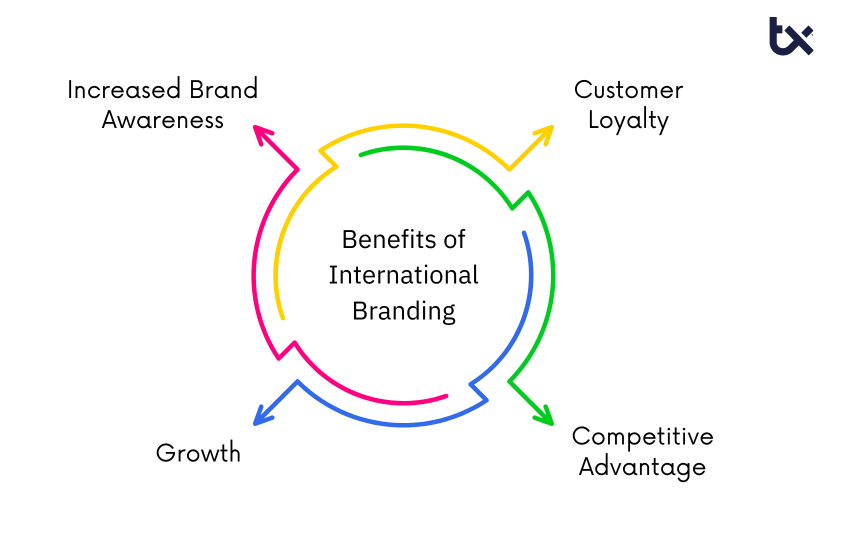Do you want to create a global brand and reach new international markets? Then you should invest in international branding!
International branding has many benefits for your business, including improved brand recognition and loyalty, competitive advantage, and increased revenue. No wonder many global brands, like Coca-Cola and McDonald’s, have implemented an international branding strategy to boost their global presence.
But what is international branding? What are its benefits and challenges? And how can you successfully implement a global branding strategy?
Keep reading to find out!
What is Ιnternational Βranding?
International branding is building a brand identity that resonates with diverse audiences across the globe. It requires adjusting your brand’s messaging, image, and experience to transcend cultural and linguistic barriers and determine how you want to be perceived by international customers.
However, international branding is more than an attempt to increase brand awareness. It also aims to increase global customers’ trust in your brand.
Therefore, adjusting to each audience’s cultural nuances and aligning your international marketing strategy with local preferences is crucial!
What are the Βenefits of Ιnternational Βranding?
International branding has many benefits for your brand, including
#1 Increased Brand Awareness
One of the most important benefits of global branding is increased brand awareness, as your brand gains exposure to diverse audiences across the globe.
This helps global customers understand your brand’s values and what you offer, increasing the chances of engaging with your brand.
Remember that remaining authentic and consistent while adapting your messaging to different local markets is essential to increase your trust and credibility globally!
#2 Opportunities for Business Growth
If you experience local market saturation, international branding may be a wise first step toward global brand expansion.
However, before entering a new market, you should know how to adjust your branding to match your target audience’s preferences. This is key to international marketing success!
International branding can help you make your brand and product appealing to global audiences, propelling your international business growth.
#3 Competitive Advantage
Staying ahead of the competition is crucial in the international market’s competitive landscape!
Implementing an international branding strategy can help you gain a competitive advantage over competitors not investing in it, solidifying your market position.
However, it is important to conduct thorough market research before entering new and emerging markets and adjust your global branding strategy accordingly.
This can help you build a good reputation, differentiate your brand from competitors in a new market, and capture market share, creating a solid foundation for future business growth.
#4 Increased Customer Loyalty
International branding can increase customer loyalty, as it helps you establish an emotional connection between global customers and your brand.
- Adjusting your branding to match cultural nuances,
- Offering a consistent service or product experience across different markets, and
- Effectively communicating your brand’s story and values
are important aspects of global branding.
They can help create a sense of familiarity that can transform into customer loyalty over time!
What are the Challenges of International Branding?
Despite its many benefits, international branding also has certain challenges you need to consider:
#1 Cultural Sensitivity
Every culture is different and has its nuances and sensitivities. Failing to adapt your global brand strategy to match them can lead to misunderstandings that can hurt your brand reputation and jeopardize your global branding efforts!
That’s why localization is key to successful global brand strategies. Localizing your website, adjusting your packaging, and adapting your brand messaging to resonate with your target audience is essential.
Although localization isn’t simple, using the right tools and practices can help you avoid pitfalls and align with cultural norms.
#2 Target Market Understanding
One of international branding’s biggest challenges is arguably understanding target markets. Many brands have failed to do this and suffered the consequences, so investing time and resources to conduct thorough market research is crucial.
Gather data regarding demographics, trends, preferences, and consumer behavior from reliable sources and use it to build an international branding strategy that aligns with your audience’s cultural identity.
Also, stay current with the ever-changing trends shaping consumer preferences and political and economic changes. Constantly adjusting your global marketing strategy based on these factors can help you remain competitive and relevant in the global marketplace.
#3 Foreign Laws and Regulations
One of the most important aspects of global branding is knowing and abiding by the laws and regulations of your target region or country.
Failing to do so can put your brand assets at risk, hurt your brand reputation, and lead to legal mishaps. So, you must familiarize yourself with your target market’s laws, regulations, and licensing requirements to ensure seamless international market expansion.
Seeking professional help is the best thing you can do to navigate foreign legal issues effectively and resolve disputes that may arise along the way.
How to Create an International Branding Strategy
Planning is very important for creating a successful global branding strategy that will help your brand grow globally! Some key steps you should follow are:
#1 Do Research to Understand Your Market
The first thing you must do before starting to plan your international branding strategy is research.
Use surveys, interviews, focus groups, and other research methods to conduct a market analysis in your target regions. Identifying local trends, preferences, and consumer behaviors will help you adjust your brand messaging and marketing strategy to match them!
#2 Create a Strong Brand Identity
It is important to create a strong and consistent brand identity that will help you increase brand awareness and engage with local customers worldwide in their native language.
Staying true to your brand’s values and goals, you should customize your brand’s message to align with local preferences and values. This is crucial for creating a global brand that will stand the test of time.
Using your market research findings and analyzing your competitors can help you in this process. But don’t forget that creativity plays a central role in building a memorable global brand!
#3 Start Localizing
Translation alone isn’t enough to expand in international markets. You must adapt your content to match local preferences and cultural nuances to ensure your brand resonates with your audience. That’s where localization comes into play!
Creating a multilingual website with localized content can help you increase visibility in local search engines and engage with international online users, thus increasing your global audience.
Remember that using the right localization tools, like Transifex AI, is key to successful localization, as it can help you save time and resources, ensuring cultural resonance.
#4 Be Consistent
Adjusting your brand messaging for international markets doesn’t mean you should sacrifice your brand’s essence.
Developing a consistent brand message is essential for a successful global brand marketing strategy, as it demonstrates what makes you unique.
Remember that aligning global brand consistency with cultural resonance is the ultimate goal! So, try to keep your brand’s message consistent across all languages and platforms while making the appropriate adjustments.
#5 Monitor and Adjust
Launching your global brand isn’t the end of the global branding process. Even if you’ve done everything right, you can never know how your global brand strategy will perform in a new market.
Therefore, monitoring and constantly optimizing your global brand performance is crucial!
- Conversion rates
- Website traffic, and
- Bounce rates
are important key performance indicators (KPIs) that will help you measure your multilingual website’s performance in a new market.
You should also be flexible and ready to adapt your global marketing strategy, as global market conditions are ever-changing. Seeking customer feedback through online surveys and interactions on Social Media is a great way to gain insight into customer satisfaction levels.
How can Transifex Help You with International Branding?
Entering international markets is exciting, but language and cultural differences can make your global marketing strategy very complex and costly. Without the right tools, expanding in new markets can mean delays, inconsistent messaging, and wasted resources.
Transifex changes that.
Your Brand, Everywhere, Effortlessly
- Speed to Market: Stop waiting months for translations. Transifex’s AI-powered tools let you localize your website, app, or software in a fraction of the time, getting you in front of new customers faster.
- Consistent Global Voice: Maintain your unique brand personality across languages. Transifex’s AI, learns your style and preferences, ensuring every translation captures your brand’s essence.
- Human-Quality Translations at Scale: Say goodbye to generic, robotic translations. Transifex’s AI delivers localized content that reads naturally, resonating with local audiences.
- Streamlined Collaboration: Keep everyone on the same page. The platform makes it easy for your team, translators, and reviewers to work together seamlessly, ensuring accuracy and brand consistency.
- Data-Driven Decisions: Make informed choices. Transifex’s built-in analytics give you the insights you need to refine your international branding strategy and maximize impact.
Your Growth, Your Way
Whether you’re entering a few new markets or going global, Transifex scales with you. With automated quality checks, ensure that your translations meet the highest standards, so you can focus on reaching your audience, not managing complex workflows.
Ready to Take the Next Step?
Sign Up for a free trial and embark on your localization journey with Transifex AI.
FAQs
What’s an International Brand?
An international brand is a brand that is recognized internationally.
What Are Some Examples of International Brands?
Apple, Samsung, Google, Coca-Cola, Nike, Tesla, and McDonald’s are some well-known international brands.
Why Should I Develop a Global Branding Strategy?
Developing a global branding strategy can help you establish your brand in foreign markets and foster an international customer base, as it can increase brand awareness, trust, and credibility. Successful global branding can also help you lower marketing costs and increase revenue over time.
What Are the Main Elements of Global Branding Strategies?
Some of the main elements of global branding strategies are consistency, research, adaptability, cultural resonance, and globalization.
What Makes a Global Brand Successful?
A strong brand identity, a flexible global marketing strategy, successful localization, and brand consistency are some aspects that make a global brand successful.












